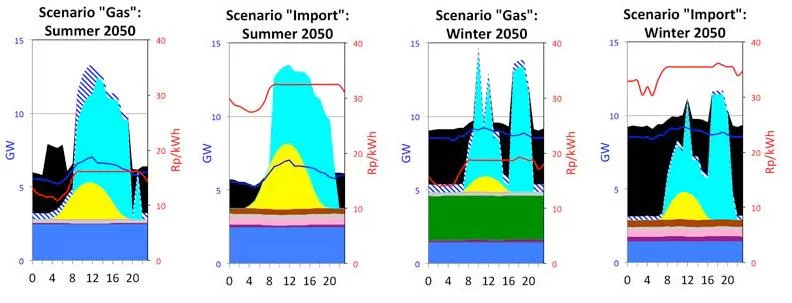The Swiss electricity system produces almost no carbon dioxide emissions due to the large contribution from hydro and nuclear power plants. However, about one-third of the country’s nuclear capacity is due to be retired in the next ten years, and the Federal Council has decided that this capacity should not be replaced with new nuclear power plants. Determining how best to fill the resulting gap between supply and demand with low-carbon electricity is complex because there is high level of uncertainty over plausible supply alternatives. For example, filling the supply gap without nuclear could increase the dependence on: seasonal hydro production; renewables with limited potential and highly variable availability; or imported electricity, for which there are security and availability concerns. In other words, aside from other uncertainties many low-carbon generation options for future supply are subject to seasonal, diurnal, or even more frequent variations in output (unlike baseload nuclear generation) which need to be integrated with variations in demand. Thus, to identify options for filling the supply gap analysis is needed of long-term electricity system development accounting for the impact of temporal variations in supply and demand. However, this cannot be analyzed with standard energy-system models (like MARKAL), or with an electricity dispatch model because they lack certain important features like a detailed depiction of the load curve (in the former) or a sufficiently long model time horizon (in the latter). Thus we are developing a new Swiss TIMES electricity sector model (STEM-E), under a least-cost optimization framework with a multi-decade time horizon and an hourly load curve. STEM-E is intended:
- to generate insights into the long-term evolution of the Swiss electricity system to meet an exogenously defined electricity demands while fulfilling secondary objectives like CO2 abatement, strategies on technology portfolio, energy security constrains, etc.;
- to analyze the electricity generation schedule at an hourly level by accounting for availability and operational constraints of interconnected system elements;
- to generate estimates of marginal cost of electricity at an hourly interval, thereby differentiating the competing technologies from conventional ranking based on levelised cost;
- to elucidate issues pertaining to integration of intermittent renewable energy technologies; to analyse the role of dam and pumped hydro in balancing the power system.
(left: summer; right: winter).
STEM-E is further developed into the European Swiss TIMES Electricity Model (EUSTEM)
Researchers
- Kannan Ramachandran
- Hal Turton
Press Releases
Relevant publications
Kannan, R., H. Turton, E. Panos (2015). Methodological Significance of Temporal Granularity in Energy-Economic Models: Insights from the MARKAL/TIMES Framework, In Giannakidis, G., Labriet, M., Ó Gallachóir, B., Tosato, G (eds.) Informing Energy and Climate Policies Using Energy Systems Models - Insights from Scenario Analysis Increasing the Evidence Base, Vol. 30, pp. 185-200, Springer ISBN 978-3-319-16540-0
Kannan, R. and H. Turton (2013). A long-term electricity dispatch model with the TIMES framework, Environment Modeling and Assessment, Vol. 18, Issue 3, pp. 325-343, DOI: 10.1007/s10666-012-9346-y
Kannan, R. and H. Turton (2012). Cost of ad-hoc nuclear policy uncertainties in the evolution of the Swiss electricity system, Energy Policy, Vol. 50, pp. 391-406, DOI: 10.1016/j.enpol.2012.07.035
Weidmann, N., R. Kannan and H. Turton (2012). Swiss climate change and nuclear policy: a comparative analysis using an energy system approach and a sectoral electricity model, The Swiss Journal of Economics and Statistics, Vol. 148 (2), pp. 275-316, External Link
Kannan, R. and H. Turton (2012). The Swiss TIMES Electricity Model (STEM-E): Updates to the model input data and assumptions (Model Release 2), Download (0.2MB)
Kannan, R. and H. Turton (2012). Nuclear policy uncertainties in the evolution of the Swiss electricity system, NES Scientific Report 2011, ISSN 1663-7380
Laboratory for Energy Analysis (2012). The new Swiss energy policy: Where will the electricity come from?, Energie-Spiegel Nr. 21, Paul Scherrer Institute, English (1.2MB), German (5.6MB)
Kannan, R. and H. Turton (2012). Swiss Electricity Supply Options: A supplementary paper for PSI's Energie Spiegel Nr. 21, EEM Working paper, Paul Scherrer Institute, External Link
Kannan, R. and H. Turton (2011). Documentation on the Development of the Swiss TIMES Electricity Model (STEM-E), PSI Bericht 11-03, Download (1.7MB)
Kannan, R. and H. Turton (2013). A long-term electricity dispatch model with the TIMES framework, Environment Modeling and Assessment, Vol. 18, Issue 3, pp. 325-343, DOI: 10.1007/s10666-012-9346-y
Kannan, R. and H. Turton (2012). Cost of ad-hoc nuclear policy uncertainties in the evolution of the Swiss electricity system, Energy Policy, Vol. 50, pp. 391-406, DOI: 10.1016/j.enpol.2012.07.035
Weidmann, N., R. Kannan and H. Turton (2012). Swiss climate change and nuclear policy: a comparative analysis using an energy system approach and a sectoral electricity model, The Swiss Journal of Economics and Statistics, Vol. 148 (2), pp. 275-316, External Link
Kannan, R. and H. Turton (2012). The Swiss TIMES Electricity Model (STEM-E): Updates to the model input data and assumptions (Model Release 2), Download (0.2MB)
Kannan, R. and H. Turton (2012). Nuclear policy uncertainties in the evolution of the Swiss electricity system, NES Scientific Report 2011, ISSN 1663-7380
Laboratory for Energy Analysis (2012). The new Swiss energy policy: Where will the electricity come from?, Energie-Spiegel Nr. 21, Paul Scherrer Institute, English (1.2MB), German (5.6MB)
Kannan, R. and H. Turton (2012). Swiss Electricity Supply Options: A supplementary paper for PSI's Energie Spiegel Nr. 21, EEM Working paper, Paul Scherrer Institute, External Link
Kannan, R. and H. Turton (2011). Documentation on the Development of the Swiss TIMES Electricity Model (STEM-E), PSI Bericht 11-03, Download (1.7MB)
Presentations
Kannan, R. and H. Turton (2011). Cost of ad-hoc nuclear policy uncertainties in the evolution of the Swiss electricity system, International Energy Workshop, Stanford, United States, Presentation
Kannan, R. and H. Turton (2010). Can a TIMES model be substituted for an Economic Dispatch model?, ETSAP Workshop, Stockholm, Sweden, Presentation
Kannan, R. and H. Turton (2010). Experience from the development of a new Swiss TIMES Electricity Model, ETSAP Workshop, New Delhi, Presentation
VBE database
Kannan, R. and H. Turton (2010). Can a TIMES model be substituted for an Economic Dispatch model?, ETSAP Workshop, Stockholm, Sweden, Presentation
Kannan, R. and H. Turton (2010). Experience from the development of a new Swiss TIMES Electricity Model, ETSAP Workshop, New Delhi, Presentation
VBE database

